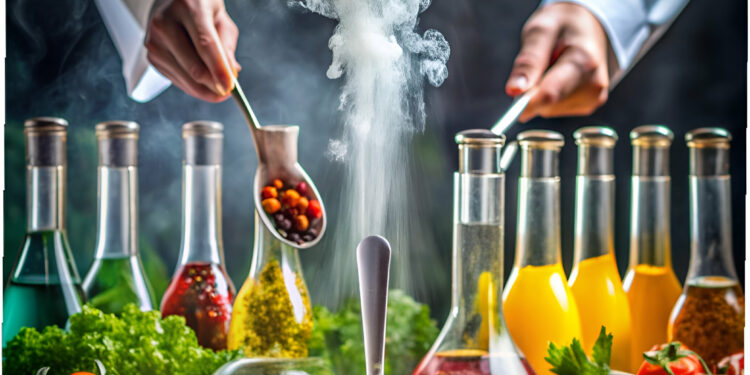Table of Contents
In the food industry today, chemicals are used in the production, preservation and enhancement of food products. From artificial additives to natural compounds, these chemicals are used to add taste, appearance and shelf life to food. But with their widespread use, concerns have arisen about their impact on our health. This post will look at the different types of chemicals in food, what they do and the risks involved. By knowing the effects of these chemicals, we can make better food choices.
Chemicals in Food: What’s in There
Chemicals in food are substances that are either naturally present or added during production and processing. Some are harmless or even good for us, others have been linked to harm. The use of chemicals in food is regulated by food authorities worldwide but there is ongoing debate about some additives long term effects.
The main categories of chemicals in food are colouring agents, preservatives and artificial sweeteners. Each of these categories has a purpose but can have positive and negative effects.
Colouring Agents
Colouring agents are substances added to food to add or impart colour. They play a big role in making food products look appealing which can affect consumer preferences and perceptions. Colouring agents are divided into two main categories: synthetic dyes and natural colouring agents.
Synthetic Colouring Agents
Synthetic dyes are man made chemicals used widely in the food industry because of their bright colours and stability. Some common synthetic dyes are tartrazine (yellow), sunset yellow (orange) and brilliant blue. These dyes are used in various food products such as candies, soft drinks and baked goods.
But synthetic dyes have been controversial because of the health risks. Studies have linked some synthetic dyes to hyperactivity in children, allergic reactions and even cancer in some cases. For example tartrazine has been linked to allergic reactions in sensitive individuals so foods with these dyes need to be carefully regulated and labelled.
Natural Colouring Agents
Natural coloring agents come from fruits, vegetables, and other natural sources. For example, carotenoids are pigments found in carrots, tomatoes, and other red, orange, and yellow fruits and vegetables. These pigments serve as natural food colorings and are considered safer than synthetic dyes.
Natural colouring agents add colour and also have health benefits. Carotenoids for example are antioxidants that protect the body from oxidative stress. But natural colourings have lower stability than synthetic dyes which limits their use in some food products.
Preservatives
Preservatives are chemicals added to food to prevent spoilage and extend shelf life. They are important in keeping food safe to eat for longer periods especially in processed and packaged foods. Preservatives can be natural or synthetic.
Natural Preservatives
Natural preservatives are salt, sugar and vinegar. These have been used for centuries to preserve food. Salt is used in curing meats, sugar in preserving fruits, and vinegar in pickling vegetables. These natural preservatives work by creating an environment that prevents bacteria, molds and yeasts from growing.
One of the most common preservation method is pasteurization, especially for milk. Pasteurization is heating milk to a specific temperature to kill harmful microorganisms and extend its shelf life without changing its taste or nutritional value.
Synthetic Preservatives
Synthetic preservatives are chemical compounds designed to prevent spoilage. Sodium benzoate is one of the most widely used synthetic preservative. It is found in acidic foods like salad dressings, carbonated drinks and fruit juices. Sodium benzoate works by inhibiting the growth of bacteria, yeast and molds making it effective in extending the shelf life of food products.
Despite their effectiveness, synthetic preservatives have raised health concerns. For example, sodium benzoate has been linked to allergic reactions, asthma and hyperactivity in children. When sodium benzoate is combined with vitamin C (ascorbic acid) it can form benzene a carcinogenic substance. So the use of synthetic preservatives is closely monitored by food safety authorities.
Artificial Sweeteners
Artificial sweeteners are synthetic compounds used as sugar substitutes. They are often hundreds of times sweeter than sugar so they can provide the desired sweetness with fewer calories. That’s why they are popular in “diet” and “sugar-free” products especially among those who want to reduce their calorie intake or manage diabetes.
Common Artificial Sweeteners
Some of the most common artificial sweeteners are aspartame, saccharin and sucralose.
- Aspartame: Aspartame is used in diet sodas, sugar-free chewing gum and low-calorie desserts. It’s 200 times sweeter than sugar but has only 4 calories per gram. But aspartame has been controversial because some people claim it causes headaches, dizziness and other health problems. While numerous research have found aspartame to be safe for most people, it is not recommended for those with phenylketonuria (PKU) who cannot metabolize phenylalanine, a component of aspartame.
- Saccharin: Saccharin is one of the oldest artificial sweetener and is 300-400 times sweeter than sugar. It’s used in tabletop sweeteners, baked goods and soft drinks. Saccharin was once thought to be carcinogenic but subsequent studies have proven it to be safe for human consumption.
- Sucralose: Sucralose is a non-caloric sweetener 600 times sweeter than sugar. Heat stable so good for baking and cooking. Found in sugar free products like ice cream, syrups and candies. While sucralose is generally considered safe some studies show it can alter gut bacteria and have other negative effects on health.
Artificial Sweeteners and Health
The health effects of artificial sweeteners is a topic of ongoing research and debate. While they can help with calorie reduction there are concerns about the long term effects. Some studies show artificial sweeteners can increase the risk of metabolic disorders like obesity and type 2 diabetes by messing with the body’s natural ability to regulate calorie intake.
Also artificial sweeteners can have a psychological effect and make us eat more calories overall. For example someone might drink a diet soda thinking they are saving calories and then compensate by eating more high calorie foods later.
Other Food Chemicals
In addition to colouring agents, preservatives and artificial sweeteners there are other chemicals in food that need attention.
Flavor Enhancers
Flavor enhancers are chemicals that intensify the taste of food without adding any nutritional value.
Stabilizers and Emulsifiers
Emulsifiers and stabilizers are added to food to improve texture, consistency and shelf life. Emulsifiers like lecithin and polysorbate 80 help mix ingredients that would otherwise separate like oil and water. Stabilizers like carrageenan and guar gum are used to maintain the texture and consistency of products like ice cream, yogurt and salad dressings.
Pesticide Residues
Pesticides are chemicals used in agriculture to protect crops from pests, diseases and weeds. While they are important for food security the residues of these chemicals can remain on food products and pose health risks. Long term exposure to pesticide residues has been linked to many health problems including cancer, hormone disruption and neurological disorders. Washing and peeling fruits and vegetables can reduce but not eliminate pesticide residues.
Quiz on Chemicals in Food and Their Effects
1: Who was the first woman President of India?
Conclusion
Food chemicals is a big issue, both good and bad. These chemicals play a big role in the production, preservation and enhancement of food but we cannot ignore their health effects. Synthetic colouring agents, preservatives and artificial sweeteners are the most debated because of their potential to cause allergic reactions, hyperactivity and other health problems.
But not all chemicals in food are bad. Natural colouring agents, salt and vinegar as preservatives and some artificial sweeteners can be part of a healthy diet when used in moderation. Protect yourself by staying informed about the chemicals in your food, reading labels carefully, and choosing products with fewer artificial additives.
Frequently Asked Questions
What are the common chemicals found in food?
Common chemicals in food include colouring agents, preservatives, artificial sweeteners, flavor enhancers, emulsifiers, and pesticide residues.
Are synthetic colouring agents safe to consume?
While synthetic colouring agents like tartrazine and sunset yellow are approved for use in food, they have been linked to allergic reactions and hyperactivity in some individuals. It’s important to consume them in moderation.
What is the purpose of preservatives in food?
Preservatives are added to food to prevent spoilage and extend shelf life. They can be natural, like salt and vinegar, or synthetic, like sodium benzoate.
How do artificial sweeteners affect health?
Artificial sweeteners like aspartame and sucralose provide sweetness with fewer calories than sugar. However, there are concerns about their long-term effects, including potential risks for metabolic disorders and changes in gut health.
Can natural food colouring agents be a healthier option?
Yes, natural colouring agents like carotenoids from fruits and vegetables are considered safer and often provide additional health benefits, such as antioxidants.
What are the health risks associated with pesticide residues in food?
Long-term exposure to pesticide residues in food has been linked to health issues such as cancer, hormone disruption, and neurological disorders. Washing and peeling produce can help reduce these risks.
Are all food chemicals harmful?
Not all food chemicals are harmful. Many natural preservatives and flavourings can be part of a healthy diet. The key is to be informed and consume these substances in moderation.












